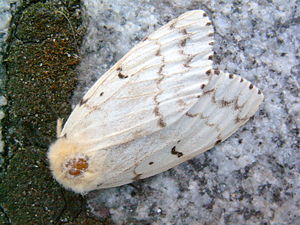
Gypsy moths in New Zealand
Encyclopedia

Gypsy moth
The gypsy moth, Lymantria dispar, is a moth in the family Lymantriidae of Eurasian origin. Originally ranging from Europe to Asia, it was introduced to North America in the late 1860s and has been expanding its range ever since...
, an invasive species
Invasive species
"Invasive species", or invasive exotics, is a nomenclature term and categorization phrase used for flora and fauna, and for specific restoration-preservation processes in native habitats, with several definitions....
from Eurasia, was discovered in New Zealand
New Zealand
New Zealand is an island country in the south-western Pacific Ocean comprising two main landmasses and numerous smaller islands. The country is situated some east of Australia across the Tasman Sea, and roughly south of the Pacific island nations of New Caledonia, Fiji, and Tonga...
but were eradicated with an intensive eradication programme. Since the gypsy moth has potentially disastrous effects on New Zealand agriculture
Agriculture in New Zealand
Agriculture in New Zealand is the largest sector of the tradeable economy, contributing about two-thirds of exported goods in 2006-7. For the year ended March 2002, agricultural exports were valued at over $14.8 billion...
planning was done to prevent the moth from becoming established.
Gypsy moth eggs are frequently found during border biosecurity
Biosecurity
Biosecurity is a set of preventive measures designed to reduce the risk of transmission of infectious diseases, quarantined pests, invasive alien species, living modified organisms...
checks, commonly on used vehicles, and were first discovered in the 1990s.
In 2003 a live adult moth in an excellent condition was found in an early warning pheremone trap in the North Island city of Hamilton
Hamilton, New Zealand
Hamilton is the centre of New Zealand's fourth largest urban area, and Hamilton City is the country's fourth largest territorial authority. Hamilton is in the Waikato Region of the North Island, approximately south of Auckland...
. Since Hamilton is an entry point for a large amount of international air freight it was assumed that the moth had entered New Zealand in an aircraft. An aerial pesticide spraying programme by the Ministry of Agriculture and Forestry using the Foray 48B
Foray 48B
Foray 48B in an insecticide manufactured by Valent BioSciences used in forestry to selectively kill the larval stage of insect in the order Lepidoptera . The active ingredient is Bacillus thuringiensis var kurstaki ....
insecticide was carried out over the city, starting from October 2003. Health concerns were raised but a report to the Ministry of Health concluded that there were no grounds for the concerns.
External links
- asiangypsymoth.org
- Gypsy Moth Surveillance Programme at Biosecurity New Zealand
- Gypsy moth at Biosecurity New Zealand

